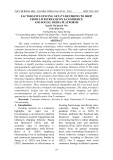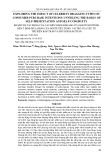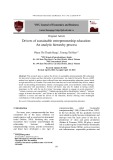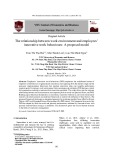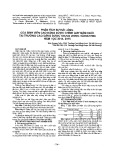
International Integration
87
1. Introduction
The service industry and the retail sector
have emerged as driving forces in economic
development in recent years. In the current
context of fierce competition among businesses,
they have continuously strived to deliver superior
service quality and establish an exceptional brand
image to achieve customer satisfaction and trust
(Dam Sao Mai et al, 2021). Several studies have
substantiated the noteworthy positive impact of
service quality on customer satisfaction. (Nguyen
Thi Kim Hiep et al, 2019; Waqas Mehmood &
Owais Shafiq, 2015; Koo D.M, 2003). In a fiercely
competitive economic landscape, the notions of
customer satisfaction and brand loyalty have
become salient concerns that hold significant
weight for business enterprises. Consequently,
the endeavor of cultivating a reputable brand
identity and enticing prospective clientele
continues to be an imperative undertaking for
marketing managers across all organizational
realms (Martin N.K, 2015). In addition to
service quality, a company with a good Brand
Image has important and positive implications
for satisfaction (Hatane Semuel et al, 2019).
Related studies have revealed that a company’s
brand, which is considered one of the intangible
resources, plays an important role in promoting
satisfaction (Martin N.K, 2015). A company’s
brand plays an important role in promoting
satisfaction and two factors have a positive impact
on customers’ purchase intention of customers
of the mobile phone industry in Pakistan (Waqas
Mehmood & Owais Shafiq, 2015).
During the global economic integration
process, especially after Vietnam joined the WTO,
Effects of service quality, brand image on
consumers’ continuous purchase intention at
supermarkets in Tra Vinh City
TRINH DUC HUY * & HO MY DUNG
Tra Vinh University
Submitted: October 04, 2023 - Revised: October 26, 2023 - Accepted: November 08, 2023
(*) Correspondence: trinhduchuy1998@gmail.com
Abstract:
The study investigated the relationship between service quality, brand image,
satisfaction, and consumers’ continuous purchase intention. We collected
research data from 258 consumers who bought goods at supermarkets in Tra
Vinh City. Quantitative research methods, including Cronbach’s Alpha for scale reliability
assessment, exploratory factor analysis (EFA), confirmatory factor analysis (CFA), and
structural equation modeling (SEM), were employed to analyze the multidimensional
relationships among the factors. The results showed that both service quality and brand
image positively affect satisfaction and consumers’ continuous purchase intention.
Furthermore, the outcomes also disclosed that brand image had a positive relationship
with consumers’ continuous purchase intention.
Keywords: Service quality, brand image, satisfaction, continuous purchase
intention.
No. 73 (83) - November and December 2023 DEVELOPMENT AND INTEGRATION

PHÁT TRIỂN & HỘI NHẬP Số 73 (83) - Tháng 11 và 12/2023
International Integration
88
Vietnam’s economy is growing more and more
vibrantly. According to data from the General
Statistics Office, as of the end of December 2021,
the country had 1167 supermarkets and 254
commercial centers. With outstanding businesses
like Big C, Lotte Mart, AEON, Saigon Co.op, and
E-Mart. In parallel with the development, retail
supermarkets have been facing many obstacles.
In 2021, the outbreak of the Covid-19 epidemic
has caused businesses in the retail industry to
face many difficulties. Currently, there is intense
competition between retail supermarkets and
shopping centers, traditional markets, retail stores,
and both domestic and foreign retail business
entities. The root cause of this competition stems
from the new regulations implemented by the
Vietnamese government. Since the beginning
of 2015, foreign retail enterprises have been
permitted to establish 100% foreign-owned
businesses in Vietnam (Tran Minh Tanh, 2018).
As a result, supermarkets of various sizes have
emerged in different locations throughout the
country.
Tra Vinh is a province situated along the
coast in the eastern region of the Mekong Delta.
Currently, according to the General Statistics
Office, the population of Tra Vinh City is
approximately 160.310 people, with about
85.513 individuals in the working age group.
During the period from 2016 to 2020, the average
GDP growth rate of Tra Vinh province achieved
a relatively high pace compared to the national
average and the Mekong Delta region, reaching
11.22%. Along with the economic development
of the city, the shopping demand of the residents
has been increasing, and their shopping habits
have also changed towards a more modern
and sophisticated approach. Consumers are
increasingly concerned about health needs, clean
products, shopping environments, promotional
programs, convenience, and customer service.
More than ever, improving the quality of retail
services is essential to compete with both
domestic and international rivals. Retail is a highly
specialized industry as it involves a combination
of products and services. Numerous prior studies
have demonstrated that increasing customer
retention rates by 5% can lead to a significant
profit enhancement, ranging from 25% to 95%.
Therefore, customer retention to encourage
ongoing shopping is of paramount importance
for the development of sustainable business.
In the context where consumers have abundant
choices for shopping and increasingly higher
demands for service quality, businesses need
to pay attention to which factors to survive and
thrive. Is it necessary for businesses to enhance
their brand image? How can they retain existing
customers? Therefore, the research on «Effects of
service quality, brand image on satisfaction and
continuous purchase intention at supermarkets in
Tra Vinh City» is truly imperative.
2. Theoretical foundations
2.1. SERVQUAL model
Parasuraman and colleagues (1985, 1988)
are pioneers in researching service quality in
marketing with specificity and detail. These
researchers proposed the SERVQUAL model, a
framework comprising five dimensions of service
quality. According to the SERVQUAL service
quality model, service quality is determined
by the gap between customers’ expectations of
service and their perceived reality of the service
received after experiencing the product or service.
SERVQUAL is designed to capture customers’
expectations and perceptions of a service along
five dimensions believed to represent service
quality.
The first gap arises when there is a disparity
between the management’s perception of this
service and customers’ expectations of service
quality.
The second gap occurs when service companies
struggle to translate customers’ expectations
into their own unit’s perceived standard of
service quality. In reality, some business units
may comprehend customer expectations, but
they may not always convert these expectations
into specific quality criteria and deliver them
according to customer expectations.
The third gap is present when there is a
discrepancy between service standards and the
actual service provided to customers. Frontline
employees play a crucial role in shaping service
quality during customer interactions. However,
not all employees can consistently fulfill their

International Integration
89
tasks according to the established criteria.
The fourth gap emerges when advertising and
informational mediums influence customers’
expectations of service quality. Customer
expectations are elevated through promises of
quality made by manufacturers and suppliers
through promotional campaigns and incentives.
Nevertheless, these promises can also diminish
customer expectations if they are not fulfilled as
pledged.
The fifth gap manifests when there is a
variance between customers’ expected and
perceived service quality. This fifth gap is pivotal
in defining service quality. Service quality is
deemed impeccable when customers perceive
no distinction between their anticipated and
experienced service quality upon consuming a
service.
2.2. Theory of consumer behavior
According to Philip Kotler (2007), consumer
behavior is influenced by both marketing factors
(product, price, distribution, promotion) and
external factors (economics, technology, politics,
culture), thereby impacting the characteristics
(cultural, social, personality, psychological) as
well as the buyer’s decision-making process
(problem recognition, information search,
evaluation, decision, purchasing behavior). In
this context, if the seller meets the necessary
criteria for the buyer, the result is a specific
shopping decision (product category, brand,
quantity, timing, place of purchase). (Fig. 1)
The stages in the process of initial purchase
were introduced by Engel, Blackwell, and Kollat
in 1968. In subsequent evolution, Professor Philip
Kotler (2011) presents the Consumer Purchase
Decision model. The stages of consumer behavior
encompass. (Fig.2)
3. Proposed research model and hypothesis
3.1. Proposed research model
Based on existing models and successful
research endeavors, the author has referenced
the SERVQUAL service quality model by
Parasuraman et al (1985, 1988). Additionally, the
author has adopted and selectively incorporated
factors from previous studies, such as Nguyen
Thi Kim Hiep et al (2019), who investigated
factors influencing customer satisfaction with
supermarket service quality; Waqas Mehmood
& Owais Shafiq (2015), who examined the
Figure 1. Buying behavior model
Source: Philip Kotler, 2007
Figure 2. Consumer decision making process
Buyer’s
Characteristics
Marketing
Stimuli
Other
Stimuli
Buyer’s Black Box
Buyer’s
Response
4 Ps
Economic
Technology
Political
Cultural
Buyer’s
Decision
Making
Process
Product choice
Brand choice
Dealer choice
Purchase timing
Purchase amount
Problem/
Purchase
Post purchase
behaviour
- Product quality (CL)
-Physical facilities (CS)
-Promotional programs (KM)
-Staff service (PV)
-Display of goods (TB)
-Supermarket safety (AT)
Brand image (TH)
H1 (+)
H2 (+)
H4 (+)
H3 (+)
on
(SHL)
Consumers'
(TTM)
No. 73 (83) - November and December 2023 DEVELOPMENT AND INTEGRATION

PHÁT TRIỂN & HỘI NHẬP Số 73 (83) - Tháng 11 và 12/2023
90
International Integration
impact of customer satisfaction, service quality
and brand image on purchase intention; Ho
Thi Huong Lan & Hoang Dang Hoa (2016),
who explored the relationship between service
quality, customer satisfaction, and customer
loyalty. The synthesized information provides a
solid scientific foundation for the development
of the proposed research model.
3.2. Research hypothesis
Service quality has been increasingly receiving
heightened attention from scholars in the field
of service marketing literature. It is defined as
the aggregate of features and characteristics of
a service that consumers anticipate or accept
(Armand V. Feigenbaum, 1945). Parasuraman et
al (1988) state that «Service quality is the gap
between customers’ expectations of the service
they are receiving and their actual perceptions
of the service they experience.» Some research
confirmed the link between service quality and
satisfaction (Nguyen Thi Kim Hiep et al, 2019;
Martin N.K, 2015).
Hypothesis H1: Service quality has a positive
impact on satisfaction.
According to legal regulations, the quality
of goods refers to the extent to which the
characteristics of the products meet the
requirements stated in applicable disclosure
standards and corresponding technical
specifications. Furthermore, the study conducted
by Le Tan Truong (2013) suggests that the quality
of goods is the perception of customers regarding
all attributes of the goods, including their nature,
characteristics, and individual value, while
considering whether these attributes align with
their needs. The research conducted by Nguyen
Thi Kim Hiep et al (2019) has demonstrated that
«the quality of goods has a positive impact on
customer satisfaction in supermarket shopping.»
Based on these findings, it is evident that the
quality of products or goods is a crucial factor
contributing to satisfaction.
Hypothesis H1.a: Product quality has a
positive impact on satisfaction.
Parasuraman et al (1985) argue that physical
facilities are among the factors that influence
service quality. This factor group includes
elements related to equipment, the appearance of
employees, and the external environment where
procedures are conducted. Nguyen Thi Kim Hiep
et al (2019) also pointed out that the physical
facilities of a supermarket encompass not only the
interior space, cashiers’ counters, or shelves for
storing products. Customers also pay attention to
other factors such as restrooms, parking lots, and
signage, especially the parking area, which should
Figure 3. Proposed research model
Source: Compiled by the author, 2023

91
International Integration
be spacious enough to provide a comfortable
space during busy shopping days and ensure
sufficient parking spaces for customers. The
research concludes that «physical facilities have
a positive impact on satisfaction in supermarket
shopping» (Nguyen Thi Kim Hiep et al, 2019).
Hypothesis H1.b: Physical facilities have a
positive impact on satisfaction.
Promotion is defined as «stimulating the
purchase of goods and services.» Therefore, the
primary purpose of promotion is to stimulate
consumer demand and encourage consumers
to purchase more of the goods and services
provided or distributed by the business.
Promotion is a tool that helps companies achieve
their marketing objectives (Martin N.K, 2015).
Authors Nguyen Thi Kim Hiep et al (2019) have
pointed out that promotional programs increase
consumers’ purchasing ability, which can lead
to customer satisfaction. Therefore, a well-
built promotion program that meets customers’
needs also significantly affects their purchasing
behavior, bringing excitement and satisfaction
when shopping at the supermarket.
Hypothesis H1.c: Promotional programs have
a positive impact on satisfaction.
The service capability of employees includes
knowledge to answer questions, feeling safe
during transactions at the store, inspiring service,
accurate communication of provided services,
attentiveness to each customer, and politeness in
transactions (Dabholkar et al, 1996). Employees
are the face of the supermarket, which is why
providing additional training in both knowledge
and soft skills for employees is crucial and
has a positive impact on customers’ shopping
experience. Furthermore, creating a conducive
work environment for employees to develop
their potential is also important (Nguyen Thi
Kim Hiep et al, 2019). The research by Tran
Minh Tanh (2018) also concludes that employees
are valuable assets of a business, especially in
the retail sector, as they represent the brand’s
image at the point of sale. The professionalism
of the staff is directly proportional to customer
satisfaction.
Hypothesis H1.d: Staff service has a positive
impact on satisfaction.
Product display can be understood as the
arrangement and presentation of products in a
specific area using the most effective methods to
persuade customers to purchase those products.
Displaying products helps customers easily
and conveniently find the items they need, and
it also aids employees in effectively managing
inventory (Tran Minh Tanh, 2018). Additionally,
the research by Ho Thi Huong Lan & Hoang
Dang Hoa (2016) concludes that the factor of
product display has a strong impact on customer
satisfaction.
Hypothesis H1.e: Display of goods has a
positive impact on satisfaction.
According to Bui Van Quang & Duong
Thanh Hien (2019), supermarkets are crowded
places with a high risk of fire, and to limit fire
hazards, supermarkets must adhere to fire safety
regulations. In another aspect, the authors argue
that in a crowded and complex environment
like a supermarket, it is susceptible to sabotage,
theft and robbery. «To enhance the quality of
supermarket services, attention must be paid to
safety factors, especially the safety of customers’
assets and money» Bui Thanh Dat (2016). In
reality, the methods of theft by perpetrators
are becoming increasingly sophisticated and
dangerous, causing customers to be concerned
and unable to shop with peace of mind in a
supermarket where theft occurs frequently.
Hypothesis H1.f: Supermarket safety has a
positive impact on satisfaction.
A brand can be understood as the term, design,
name, symbol, or any other feature that helps
differentiate a company’s products from those
of other companies, the brand image is also the
image that customers acquire when engaging in
the service, representing a distinct system through
the services provided, encompassing tangible
elements (physical facilities and personnel) and
intangible aspects, as well as indirect experiences
through communication and word-of-mouth (Vo
Thi Ngoc Thuy, 2016). According to the research
conducted by Martin N.K (2015), brand image is
an important antecedent of customer satisfaction.
Therefore, a supermarket brand with a positive
image is likely to generate higher customer
satisfaction within the store.
No. 73 (83) - November and December 2023 DEVELOPMENT AND INTEGRATION

